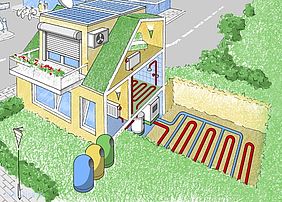Today, heat pumps are increasingly developing into a sustainable and efficient alternative to furnaces in climates with moderate heating and cooling needs. Heat pumps are systems that move heat from one place to another by using a compressor and a circulating structure of liquid or gas refrigerant, through which heat is extracted from outside sources and pumped indoors. As heat pumps only move heat, heat pumps enable space conditioning at one quarter of the cost of operating conventional heating or cooling appliances. Using environmental energy also ensures less carbon dioxide emissions. Heat pumps, however, still primarily use refrigerants that are harmful to the environment.
Now (2019), researchers at Fraunhofer ISE have developed a climate-friendly alternative, which uses propane as a refrigerant. Using propane, the greenhouse gas potential is about 500 times less than with conventional refrigerants. With 150 grams of propane, the heat pump reaches eight kilowatts heating power. Thus the unit can be installed inside a building without having to worry about additional safety requirements. Each kilowatt needs about 20 grams of propane. Commercially available systems currently use 80 to 90 grams coolant per kilowatt power. This is why most heat pump systems currently available are exclusively for outdoor installation. The Fraunhofer ISE researchers used components which were available on the market to build the prototype. The main feature of the design is the use of asymmetrical plate heat exchangers. Since most of the refrigerant was located in the heat exchangers and pipe system of the heat pump, the optimization of the heat exchanger had a great effect on the reduction of the used refrigerant. Due to its design, the asymmetrical heat exchanger did not require as much refrigerant.
For many years, scientists have tried to design cost-efficient and energy-efficient heat pump systems for indoor use. In 2014, an earth type heat pump with a heat exchanger was designed which consisted of an evaporator coil and a compressor, condenser, receiver and expansion valve in series, with the evaporator coil for delivering heat picked up at the heat exchanger from the condenser, and heat pickup tubes positioned vertically in the earth and connected with the heat exchange structure for passively supplying heat from the earth to the heat exchanger by means of a refrigerant passing between the heat pickup tubes and heat exchange structure. In one modification, the heat of the earth was supplemented by a solar heating system including a collector and heater tubes connected to the collector positioned vertically and interspersed with the heat pickup tubes of the heat pump. In another modification of the invention, heat transfer between the vertically positioned tubes was promoted by moistening the earth around the vertical heat pickup tubes and the heater tubes.
In 2011, scientists developed a heat pump system which included a compressor, a reversing valve, an outdoor heat exchanger and an indoor heat exchanger in a circuit, and a refrigerant-to-water heat exchanger. In the air cooling with water heating mode, the air heating with water heating mode and the water heating only mode, water from a water reservoir was passed through a refrigerant-to-water heat exchanger. A refrigerant line coupled the reservoir to the refrigerant circuit intermediate, the outdoor and indoor heat exchangers for directing liquid refrigerant into the reservoir and a refrigerant line coupled the refrigerant circuit upstream of the suction inlet to the compressor for returning the refrigerant to the refrigerant circuit. A controller controlled the flow into and from the refrigerant reservoir through the selective opening and closing of a controlled valve in line and control valve in line.
The advantages of the new design are numerous: as a coolant, propane is climate friendly, relatively inexpensive, readily available, and has high coefficients of performance. As it is a flammable gas, however, the safety regulations for its use as a heat pump refrigerant, also known under the name of R290, are quite elaborate. A heat pump in a single-family home ranges between five and ten kilowatts power. If the upper limit of 150 grams coolant is exceeded, the heat pump can be installed only by implementing extensive and costly safety requirements. This is the reason why propane heat pumps which can be set up inside the building are almost non-existent on the market.
Another advantage is that the new prototype requires only a quarter of the refrigerant compared to conventional heat pumps available on the market at the same power. A propane heat pump based on this development would be the first-of-a-kind in Germany which has been permitted in interior spaces of residential buildings without implementing additional safety measures.
The objective of this outstanding design is to develop a heat pump that uses a climate-friendly refrigerant and at the same time achieves high power and efficiency using the lowest possible amount of refrigerant. The first goal has been achieved. The prototype reached the level of power envisioned for this market segment at a very low refrigerant charge, bringing the vision of an indoor installation closer to reality.
